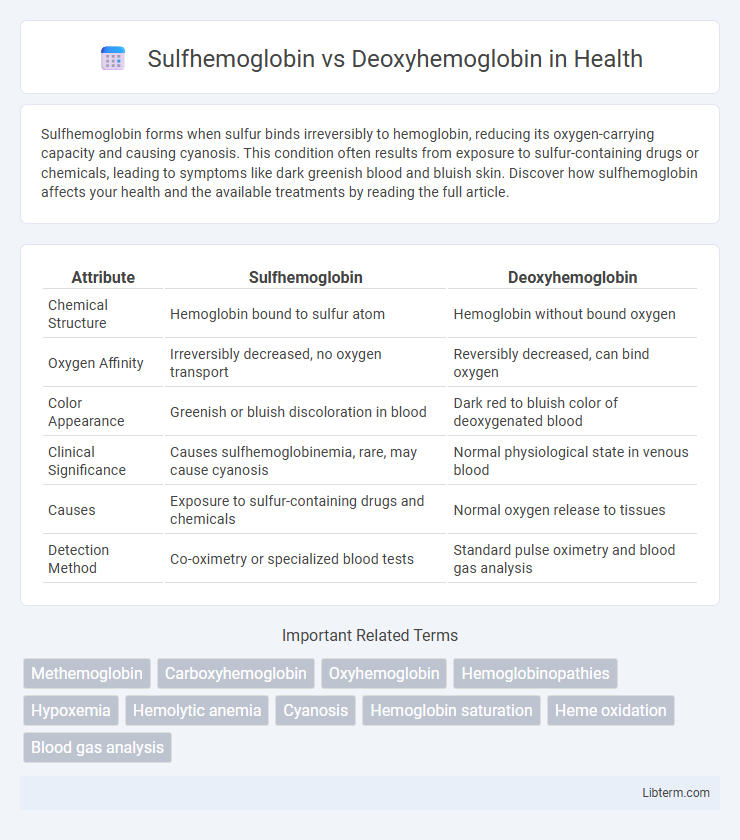Sulfhemoglobin forms when sulfur binds irreversibly to hemoglobin, reducing its oxygen-carrying capacity and causing cyanosis. This condition often results from exposure to sulfur-containing drugs or chemicals, leading to symptoms like dark greenish blood and bluish skin. Discover how sulfhemoglobin affects your health and the available treatments by reading the full article.
Table of Comparison
| Attribute | Sulfhemoglobin | Deoxyhemoglobin |
|---|---|---|
| Chemical Structure | Hemoglobin bound to sulfur atom | Hemoglobin without bound oxygen |
| Oxygen Affinity | Irreversibly decreased, no oxygen transport | Reversibly decreased, can bind oxygen |
| Color Appearance | Greenish or bluish discoloration in blood | Dark red to bluish color of deoxygenated blood |
| Clinical Significance | Causes sulfhemoglobinemia, rare, may cause cyanosis | Normal physiological state in venous blood |
| Causes | Exposure to sulfur-containing drugs and chemicals | Normal oxygen release to tissues |
| Detection Method | Co-oximetry or specialized blood tests | Standard pulse oximetry and blood gas analysis |
Introduction to Hemoglobin Variants
Sulfhemoglobin and deoxyhemoglobin are distinct hemoglobin variants with different physiological and pathological implications. Sulfhemoglobin forms when sulfur binds irreversibly to the hemoglobin molecule, impairing oxygen transport and leading to cyanosis, while deoxyhemoglobin represents hemoglobin in its oxygen-unbound state during normal oxygen delivery to tissues. Understanding these variants is crucial for diagnosing causes of hypoxemia and differentiating between reversible oxygen deprivation and toxic hemoglobin alterations.
What is Sulfhemoglobin?
Sulfhemoglobin is an abnormal hemoglobin variant formed when sulfur atoms irreversibly bind to the hemoglobin molecule, impairing its oxygen-carrying capacity. Unlike deoxyhemoglobin, which is the reduced form of normal hemoglobin lacking oxygen but capable of oxygen binding, sulfhemoglobin cannot reversibly bind oxygen, leading to cyanosis and potential hypoxia. Sulfhemoglobinemia typically arises from exposure to sulfur-containing drugs or environmental toxins, distinguishing it from the physiological oxygen-release function of deoxyhemoglobin.
What is Deoxyhemoglobin?
Deoxyhemoglobin is the form of hemoglobin that is not bound to oxygen, present in red blood cells after oxygen is released to tissues. It plays a crucial role in transporting carbon dioxide and protons back to the lungs for exhalation, maintaining acid-base balance in the blood. Unlike sulfhemoglobin, which contains sulfur atoms and cannot carry oxygen effectively, deoxyhemoglobin retains the ability to reversibly bind oxygen once it reaches the lungs.
Formation Mechanisms: Sulfhemoglobin vs Deoxyhemoglobin
Sulfhemoglobin forms when sulfur atoms irreversibly bind to the heme group, typically due to exposure to sulfur-containing drugs or toxins, preventing oxygen binding and leading to a permanent greenish pigment. Deoxyhemoglobin arises when hemoglobin releases oxygen to tissues, causing iron in the heme to revert to the ferrous state without oxygen attached, allowing reversible oxygen transport. The key difference in formation lies in sulfhemoglobin's irreversible sulfur incorporation versus deoxyhemoglobin's reversible oxygen release mechanism.
Structural Differences between Sulfhemoglobin and Deoxyhemoglobin
Sulfhemoglobin contains a sulfur atom irreversibly bound to the heme group, altering its molecular structure and preventing efficient oxygen binding. In contrast, deoxyhemoglobin lacks oxygen in its heme sites but retains the normal iron configuration without sulfur incorporation. This structural modification in sulfhemoglobin reduces its oxygen-carrying capacity compared to the reversible oxygen binding seen in deoxyhemoglobin.
Functional Differences in Oxygen Transport
Sulfhemoglobin irreversibly binds to hemoglobin, impairing its ability to carry oxygen by altering the heme group and reducing oxygen affinity. In contrast, deoxyhemoglobin is the form of hemoglobin without bound oxygen, readily capable of binding oxygen in the lungs and releasing it in tissues. Sulfhemoglobin presence leads to functional hypoxia due to diminished oxygen transport, whereas deoxyhemoglobin participates dynamically in oxygen delivery under normal physiological conditions.
Clinical Significance and Manifestations
Sulfhemoglobin forms when sulfur atoms irreversibly bind to hemoglobin, resulting in impaired oxygen delivery and persistent cyanosis unresponsive to oxygen therapy, often associated with exposure to sulfur-containing drugs or chemicals. Deoxyhemoglobin represents hemoglobin without oxygen binding, playing a key role in normal oxygen transport but contributing to central cyanosis during hypoxemia. Clinically, sulfhemoglobinemia requires identification through co-oximetry due to its resistance to oxygen treatment, while deoxygenated hemoglobin-related cyanosis improves with oxygen supplementation.
Diagnostic Approaches and Identification
Sulfhemoglobin and deoxyhemoglobin differ significantly in their diagnostic identification, with sulfhemoglobin requiring co-oximetry for accurate detection due to its unique absorption spectrum around 620 nm, whereas deoxyhemoglobin is typically identified using standard pulse oximetry and blood gas analysis. Laboratory methods such as spectrophotometry and high-performance liquid chromatography (HPLC) are critical for differentiating sulfhemoglobin from carboxyhemoglobin and methemoglobin, ensuring precise diagnosis in clinical settings. Accurate identification of these hemoglobin variants is essential for determining appropriate treatment strategies in conditions like sulfhemoglobinemia and hypoxemia.
Treatment and Management Strategies
Treatment and management of sulfhemoglobinemia primarily involve discontinuing exposure to offending sulfur-containing drugs or chemicals, as the condition is usually benign and resolves once the source is removed. Deoxyhemoglobin-related hypoxia requires addressing underlying causes such as respiratory or circulatory disorders, often employing supplemental oxygen, mechanical ventilation, or medications to improve oxygen delivery and tissue perfusion. Monitoring oxygen saturation and arterial blood gases guides therapeutic interventions for both conditions, with specific antidotes rarely necessary for sulfhemoglobinemia.
Key Takeaways and Summary
Sulfhemoglobin is a rare hemoglobin variant formed by the irreversible binding of sulfur to the heme moiety, impairing oxygen delivery and causing cyanosis without significantly affecting oxygen affinity. Deoxyhemoglobin represents the normal, oxygen-free form of hemoglobin capable of readily binding oxygen in the lungs and releasing it to tissues, maintaining physiological oxygen transport. Understanding the distinction between sulfhemoglobin and deoxyhemoglobin is crucial for diagnosing dyshemoglobinemias and managing conditions involving impaired oxygen transport.
Sulfhemoglobin Infographic

 libterm.com
libterm.com